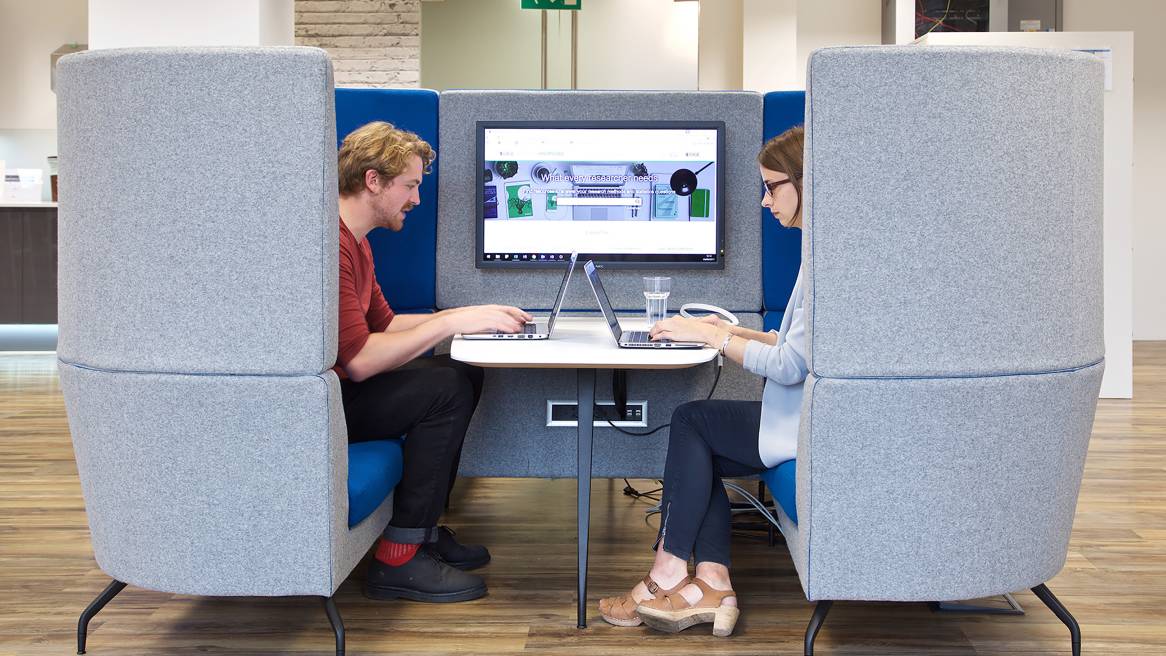Six Education + Work Trends from Generation iGen
The first generation to never live without tech at their fingertips is shifting the landscapes of education and work.
Can you imagine growing up with modern technology since the day you were born? iGen can.
Born between 1995–2012, iGen is the first generation to never experience a world without universal access to the internet and personal devices. By the time the first group of iGeners turned five-years-old, Y2K and the worry of crashing computer networks saturated the news. With technology tied to their earliest memories, it’s easy to understand why iGen views work and school unlike any generation before.
To discover more about this unique group and trends on the horizon in education and workplace design, Steelcase visited the 10th anniversary of Clerkenwell Design Week in London. There, Orangebox Digital Manager Nathan Hurley talked about “Smartlearning: How iGen’s Educational Experience Will Impact the Workplace.” He provided insights on what makes this generation different than its predecessors and six trends he believes are impacting higher education institutions and workplace design today and in the years to come.

1. Smartlearning: Big Business and Bigger Brands
iGen adults view themselves as constant customers, even when it comes to education. Instead of only seeking out a university known for its academic excellence, Hurley describes how students are “shopping” for the one that will provide the experience they are looking for.
To capture their attention, higher educational institutions are investing in selling a lifestyle, branding themselves the same way big-name companies do. Researchers from London Metropolitan University surveyed over 190 young adults who were likely to enter college on the marketing effects of three universities. The results show students value branding elements focused on a university’s social environment, and the amount of student support offered, much higher than more traditional marketing materials centered on the institution’s mission and values when evaluating a university.
2. The Social Campus
The library is the new student union. Transitioning from a place for quiet, focus work, libraries are now hyperconnected spaces where students can work alone or together in a range of environments. Innovative designs cater to student needs, offering them a choice over when, where and how they want to work to be the most productive.
After studying and collaborating in beautiful libraries, iGen graduates often enter workplaces that lack the technology and performance they expect. Downgrading in terms of space, functionality and design leaves them with a large potential for dissatisfaction with the workplace. Hurley cautions organizations must prioritize technology and offer a range of spaces to attract and retain the best talent.
3. Flipped Learning
We’ve all heard the 4 Cs — communication, collaboration, critical thinking and creativity. Companies today are seeking these soft skills in students, so it’s vital they are developed and honed in higher education. One pedagogy that fosters these behaviors is flipped learning, where students watch pre-recorded video lectures by their professors at home and do homework with peers in the classroom. A flipped classroom requires a different design approach, one that encourages mobility, group work and interacting with information.
4. University YouTube
There is little iGen can’t learn on YouTube. In 2017 YouTube reported people watch over 1 billion hours of video on the platform every day. iGen is familiar with online learning, and they prefer it to traditional methods. This confidence in online education led to popularity in Massive Open Online Courses (MOOCs), says Hurley, where anyone, anywhere can learn a range of things on demand.
These courses have an impact on physical space, suggesting it be more fluid so it mirrors the digital realm students are versed in. Education institutions and workplaces should consider gravitating to more informal and flexible tools for learning, so students and workers stay up-to-date and engaged.
5. Career Tinder
iGen isn’t trying to find a job for life; they don’t even consider having the same job for a decade, says Hurley. With an open mind for potential positions, apps like Switch App and Labour Xchange provide instant access to thousands of job opportunities, allowing many iGeners to swipe left or right for a new job in the same way they do to find a date.
However, what happens with recruiters? And how do organizations entice iGen workers to stay when a new job is a click away? The answers to these questions aren’t fully developed, but Hurley advises we are now in the perfect storm to rethink education and the physical space in which learning and working happens.
6. Sticky Campus
Google offers everything an employee needs on campus — free food for every meal, gyms, massage therapists — the perks are so good, workers stay. Universities are following the lead of innovative companies like Google, notes Hurley. For the first time, higher education institutions are interested in experiential design, creating campuses that are open 24/7 and offer the optimal experience, an experience so great students can’t imagine leaving.
TECH TO CLOSE THE GAP
While some universities are forward-thinking, the vast majority are far behind in preparing iGen for the future. Research from Gallup shows there is a huge gap between chief academic officers of colleges and universities who say they prepare students for the workforce (96%) and only 11% of corporations that say they do. With Google, YouTube and other channels becoming education platforms and iGen needing to learn new skills throughout their life to successfully shift careers, the world of learning is prime for a massive change.
To begin this shift, businesses and universities would be wise to learn from each other, said Hurley. Companies can look to modern libraries to learn how to be more flexible and less hierarchical. Universities can learn from innovative organizations on how to offer perks and benefits that make students want to stay.
Both the world of learning and work must evolve to attract and retain iGen talent. Workplaces and higher education institutions need to provide spaces where technology doesn’t only enhance the experience; it is the experience — because, for iGen, that’s the only world they’ve ever known.


